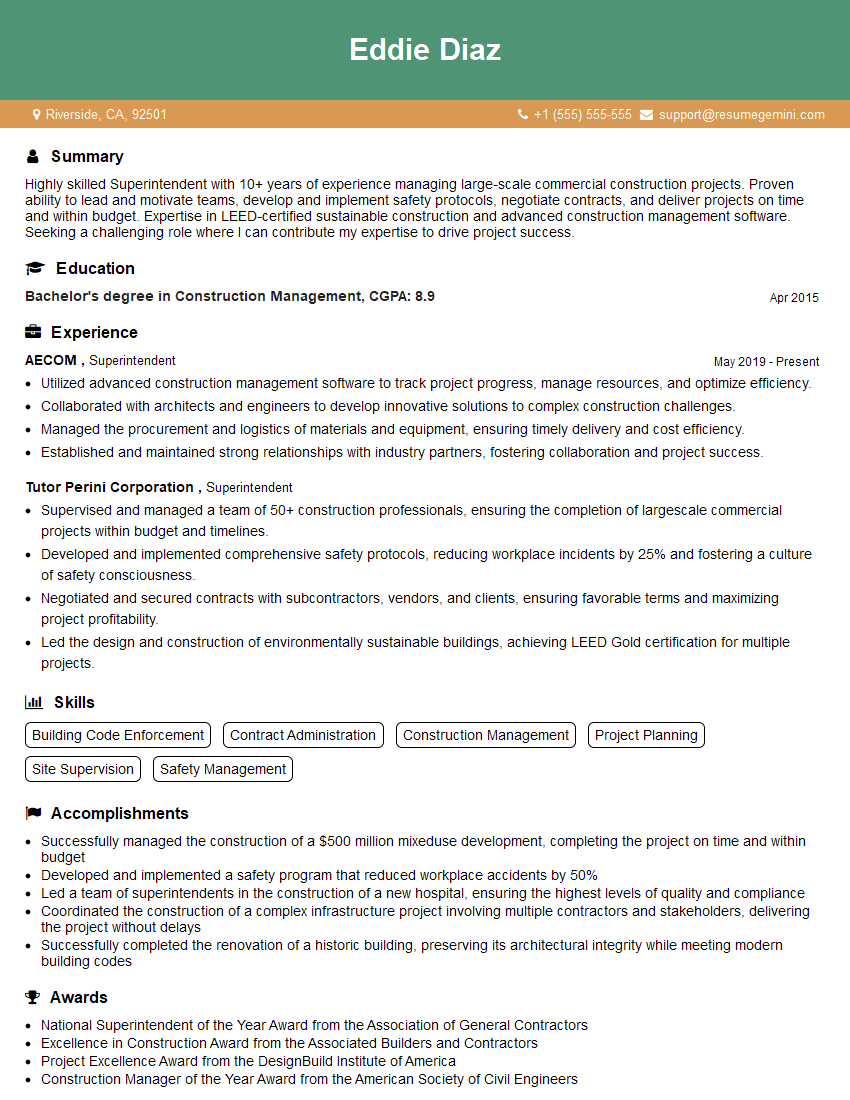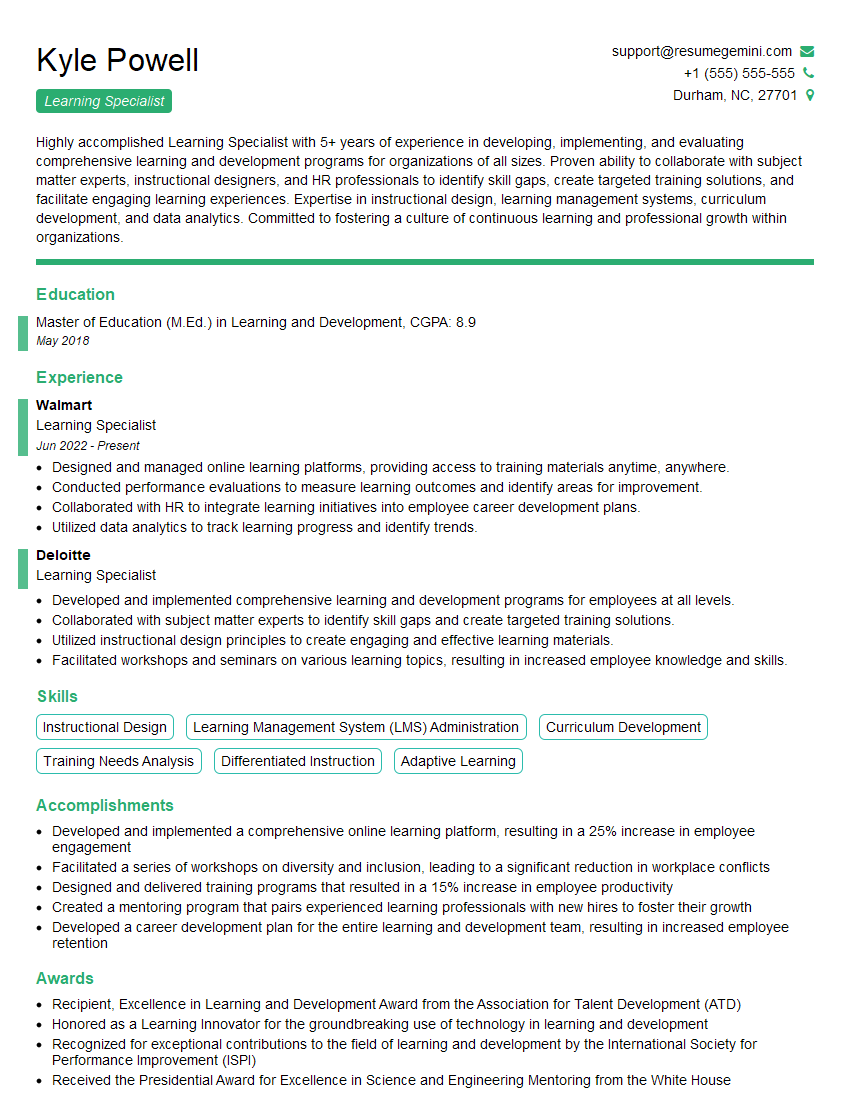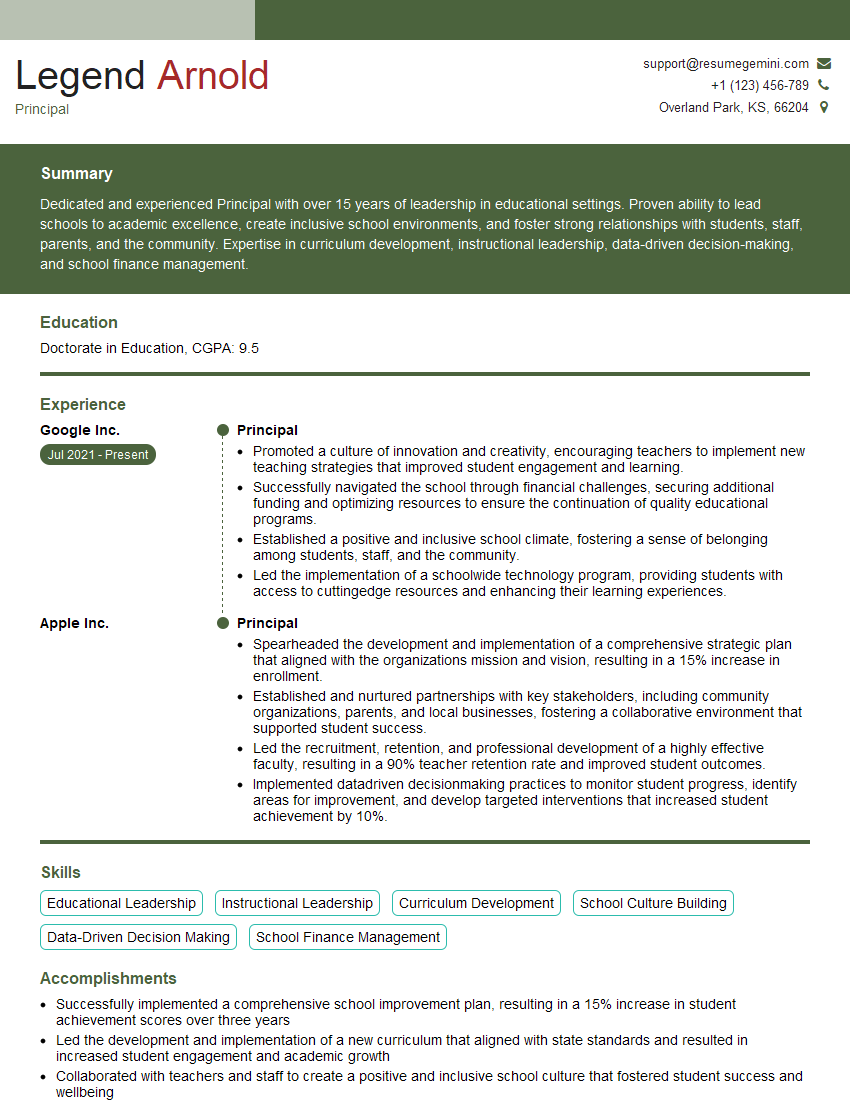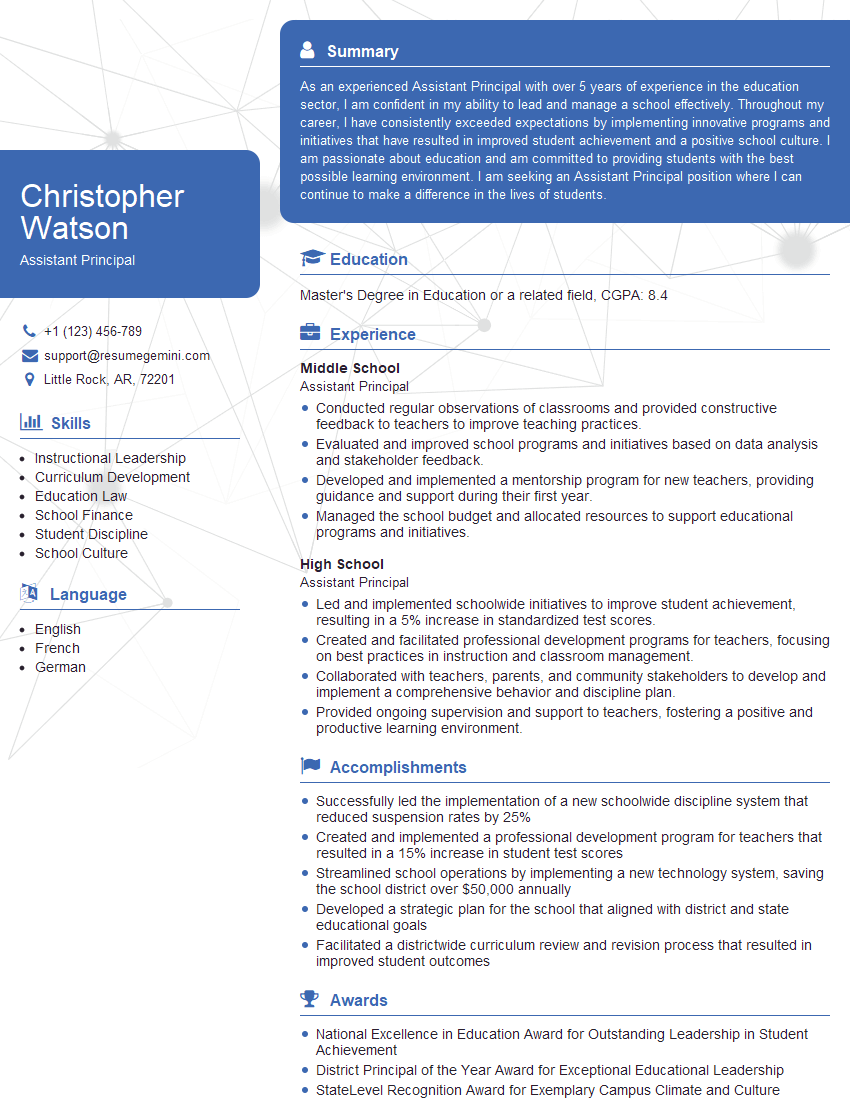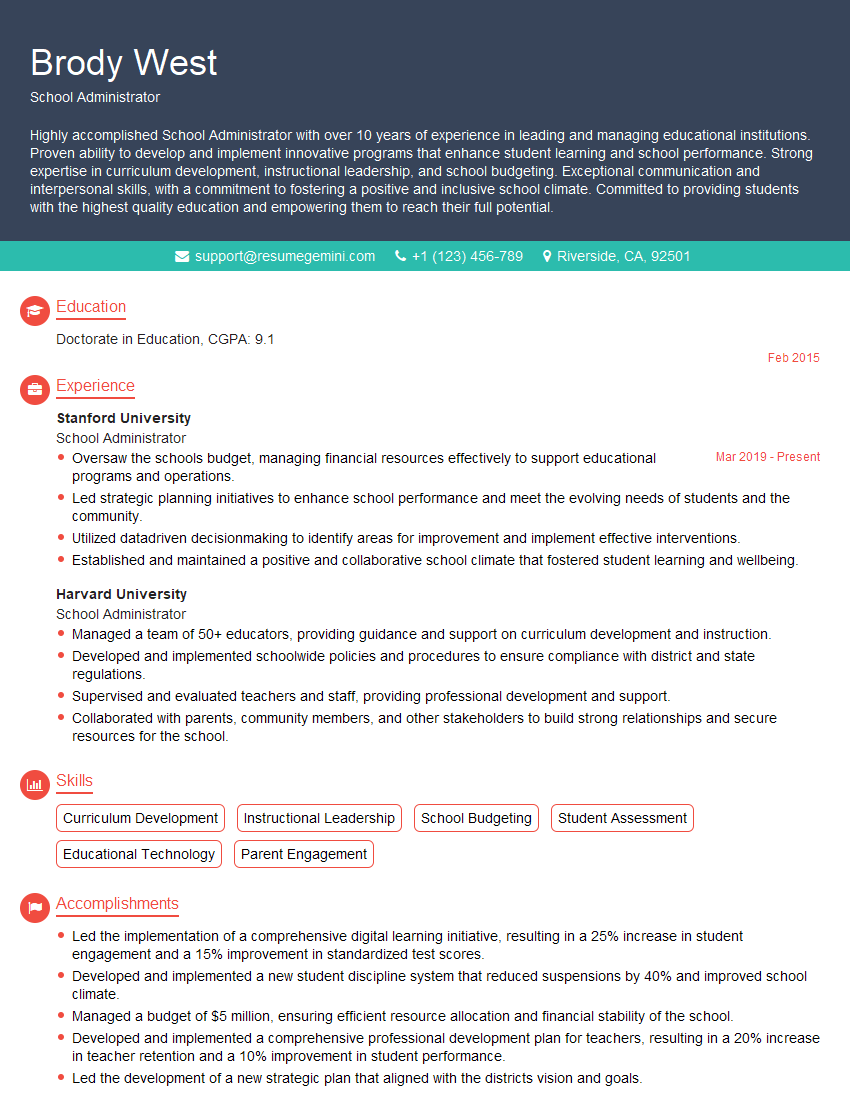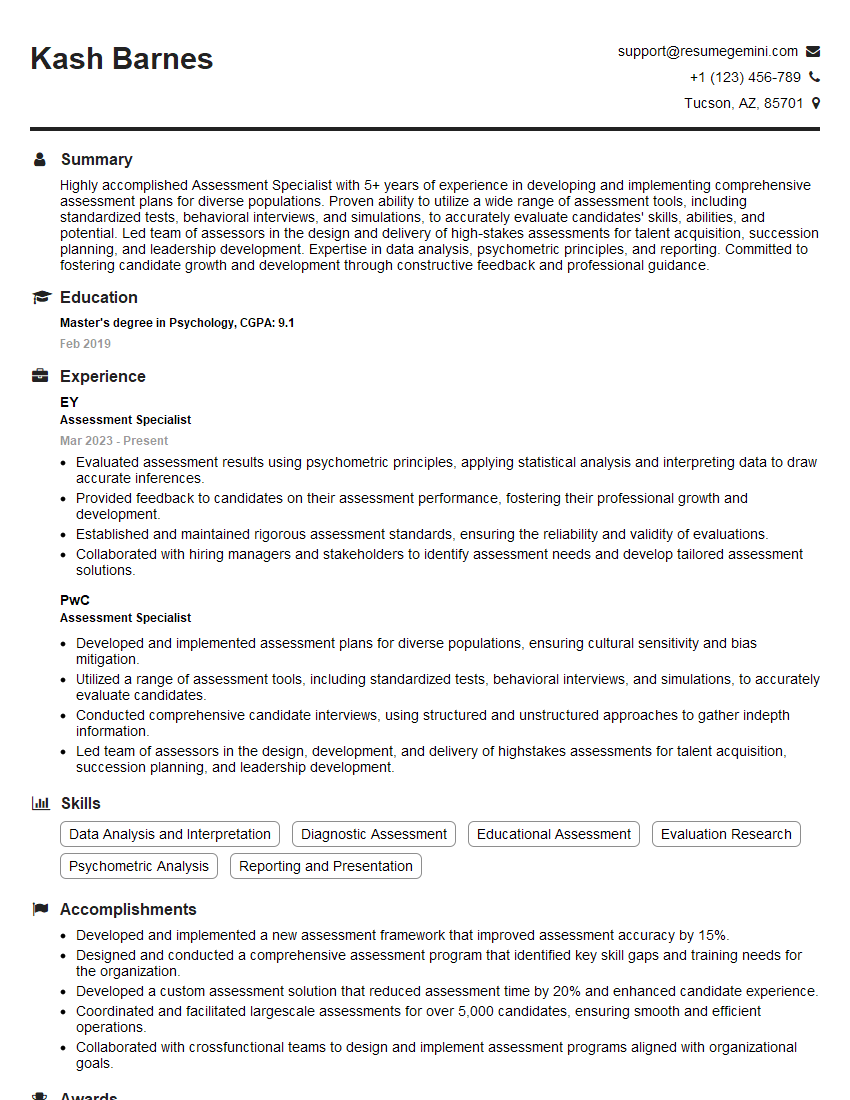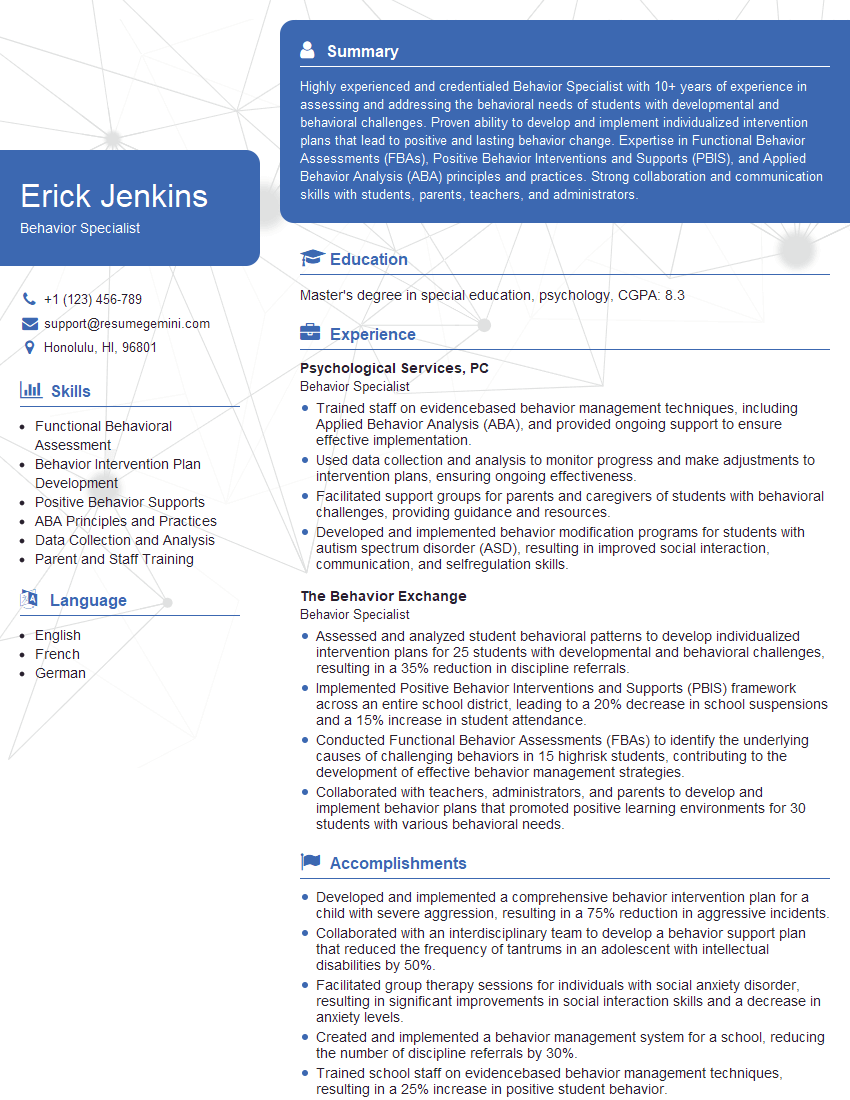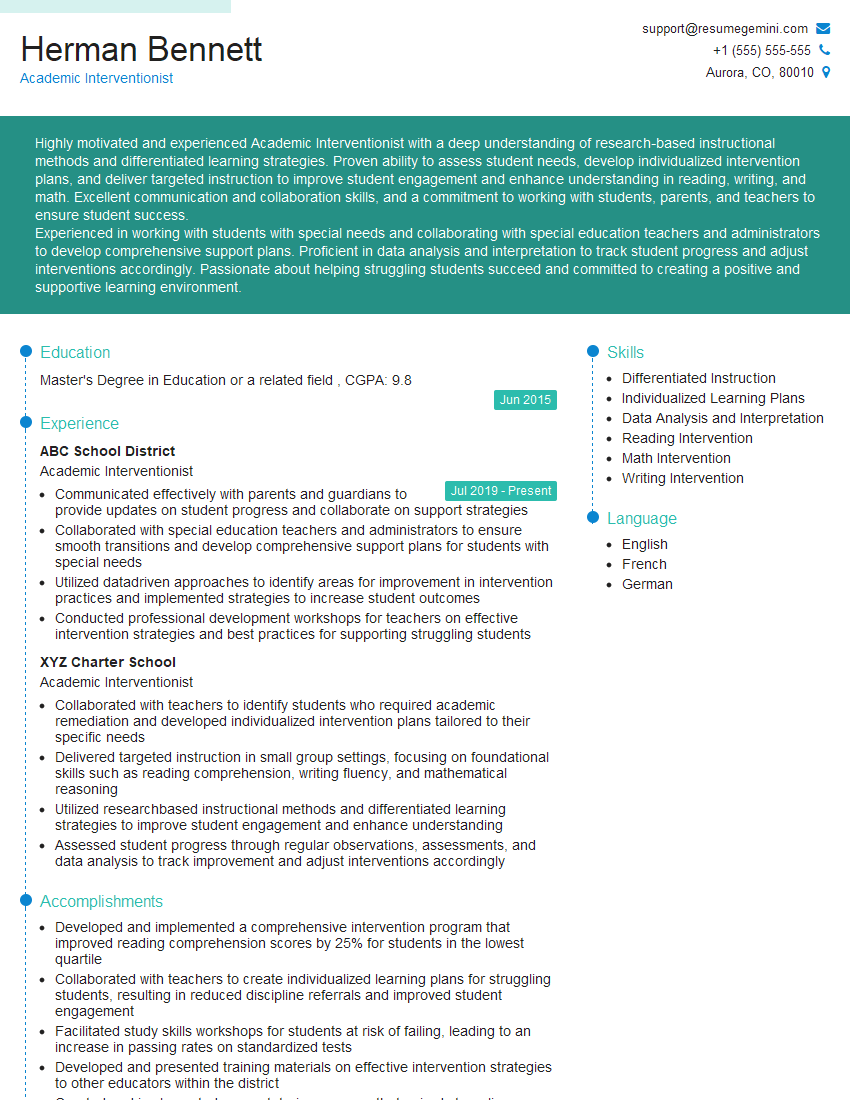Unlock your full potential by mastering the most common School Consultation interview questions. This blog offers a deep dive into the critical topics, ensuring you’re not only prepared to answer but to excel. With these insights, you’ll approach your interview with clarity and confidence.
Questions Asked in School Consultation Interview
Q 1. Describe your experience conducting functional behavioral assessments.
Functional Behavioral Assessments (FBAs) are systematic processes used to understand the function or purpose of a student’s challenging behavior. Instead of simply labeling the behavior as ‘bad,’ an FBA helps identify the triggers, antecedents, and consequences that maintain the behavior. This understanding is crucial for developing effective interventions.
My approach involves a multi-step process: First, I gather data through direct observation, interviews with teachers, parents, and the student (if appropriate), and review existing school records. This data helps build a picture of the behavior—when it occurs, what happens before and after, and the context in which it happens. Next, I analyze this data to identify patterns and formulate hypotheses about the function of the behavior. For example, is the behavior serving to escape a demanding task, gain attention, or access to preferred items? Finally, I collaborate with the school team to develop a Behavior Intervention Plan (BIP) based on the identified function. The BIP outlines specific strategies to prevent the behavior and teach alternative, more appropriate behaviors.
For example, I worked with a student who frequently disrupted class. Through observation and interviews, we found the disruptions occurred most often when he was assigned independent written work—a task he found difficult. The function of his behavior was escape. The BIP we developed included strategies to break down the task into smaller, more manageable steps, providing frequent positive reinforcement for on-task behavior, and teaching him self-regulation strategies.
Q 2. Explain your approach to collaborating with teachers to improve classroom management.
Collaborating with teachers on classroom management is a cornerstone of my work. My approach is built on a foundation of mutual respect and shared understanding. I believe in empowering teachers by providing them with evidence-based strategies tailored to their specific classroom contexts. I avoid a ‘top-down’ approach; instead, I work as a partner, actively listening to teachers’ concerns and leveraging their existing expertise.
My collaboration usually involves: initial consultation meetings to assess the classroom climate and challenges; classroom observations to gather data and identify patterns; co-developing and implementing classroom management strategies, such as positive behavior supports, clear expectations, and consistent consequences; ongoing feedback and support, adapting strategies as needed; and providing teachers with resources and professional development opportunities.
In one instance, a teacher expressed frustration with consistent off-task behavior among her students. Through observation, we found the issues stemmed from unclear expectations and inconsistent application of classroom rules. We collaboratively developed a visual schedule, clear classroom rules posted at student eye-level, and a system of positive reinforcement. The teacher was actively involved in each step, which fostered ownership and significantly improved classroom management.
Q 3. How do you utilize data to inform your consultation services?
Data is the lifeblood of effective school consultation. I utilize a variety of data sources to inform my services, including academic performance data, attendance records, discipline referrals, behavioral observation data, and assessment results. I believe in using data to inform decision-making, track progress, and evaluate the effectiveness of interventions.
For instance, if a pattern emerges showing a spike in discipline referrals during certain times of the day or in specific classrooms, this data points to potential underlying issues requiring attention. Similarly, analyzing academic data can illuminate learning gaps that might be contributing to behavioral issues or low student engagement. I then use this data to tailor my recommendations to address the specific needs of the students and the school. I might present my findings visually using graphs and charts to facilitate understanding and promote data-driven decision making.
My use of data is not just about numbers; it’s about telling a story about what’s happening in the school and how we can best support the students and staff.
Q 4. What strategies do you employ to build rapport with teachers and administrators?
Building rapport is essential for successful school consultation. I prioritize building trust and open communication with teachers and administrators. My approach is based on empathy, active listening, and demonstrating genuine respect for their roles and expertise.
I begin by actively listening to their concerns, acknowledging their perspectives, and framing my role as a collaborative partner rather than an outside expert imposing solutions. I make a point of understanding their challenges and the school’s context before offering suggestions. I also strive to be responsive to their needs, providing timely feedback and maintaining consistent communication. In some cases, I may start with informal conversations to get to know them better and build a foundation of mutual respect before formal consultations begin.
Showing appreciation for their hard work and dedication goes a long way. For example, simply acknowledging the challenges of their roles and expressing gratitude for their willingness to collaborate can make a big difference.
Q 5. Describe a time you had to address a conflict between teachers or staff.
In one school, a conflict arose between two teachers regarding classroom resources and scheduling. Both teachers felt their needs were not being met, leading to tension and impacting their collaboration. My approach involved individually meeting with each teacher to understand their perspectives, needs, and concerns in a non-judgmental environment. I actively listened to both sides, ensuring each felt heard and understood. Once I had a clearer picture of the situation, I facilitated a meeting between the two teachers in a neutral setting.
During the meeting, I created a safe space for open communication and encouraged them to express their concerns respectfully. I acted as a mediator, helping them identify common ground and find mutually acceptable solutions. The focus was on problem-solving collaboratively, rather than assigning blame. We explored alternative scheduling options and resource allocation strategies to address their needs. The conflict resolution resulted in improved communication, cooperation, and a more positive working relationship between the two teachers.
Q 6. How do you prioritize multiple competing demands in a school setting?
Prioritizing competing demands in a school setting requires a systematic approach. I use a combination of strategies, including: clearly defining my roles and responsibilities, establishing priorities based on urgency and impact, utilizing time management techniques like scheduling and prioritization matrices (e.g., Eisenhower Matrix), and delegating tasks when appropriate.
I regularly review my workload, identifying tasks that align with the school’s overall goals and those that have the greatest potential impact on student outcomes. I prioritize tasks based on urgency and importance, focusing on immediate needs while also planning for long-term goals. Collaboration with administrators is essential in identifying and managing priorities, ensuring alignment with the school’s strategic plan. Effective communication and clear expectations are key to managing competing demands and avoiding burnout.
For example, if I have multiple requests for consultations, I would prioritize based on factors such as the urgency of the situation (e.g., a crisis situation versus a long-term planning issue), the potential impact on students, and the availability of resources. This requires continuous assessment and adjustment of priorities to effectively meet the demands of the school setting.
Q 7. Explain your understanding of different learning styles and how you adapt your strategies accordingly.
Understanding different learning styles is crucial for effective consultation. I recognize that students learn in diverse ways, utilizing various cognitive, emotional, and sensory preferences. Some learners are visual, others auditory, and some kinesthetic. My strategies incorporate this diversity.
When working with teachers, I adapt my approach to match their preferred learning styles. For example, I may use visual aids like charts and diagrams for visual learners, provide verbal explanations and discussions for auditory learners, and incorporate hands-on activities for kinesthetic learners. Furthermore, I make sure materials and strategies are flexible and cater to the diverse needs of all learners within a classroom. This might involve offering differentiated instruction, providing multiple means of representation, action and expression, and engagement.
In practice, this means that I wouldn’t simply recommend a single approach for a classroom behavior issue. Instead, I would work with the teacher to identify the learning styles of their students and develop a range of interventions that cater to these diverse needs. This might include visual schedules for students who respond well to visual cues, peer tutoring for students who benefit from social interaction, and hands-on projects for kinesthetic learners. This ensures that the interventions are not only effective but also engaging and supportive for all students.
Q 8. What are your preferred methods for providing feedback to teachers?
Providing effective feedback to teachers requires a nuanced approach that balances constructive criticism with encouragement. My preferred method involves a collaborative, solution-focused model. I begin by establishing a strong rapport and emphasizing the shared goal of student success. I favor a three-pronged approach:
- Strengths-Based Feedback: I always start by highlighting the teacher’s existing strengths and successful strategies. This sets a positive tone and creates a receptive environment for further discussion.
- Specific and Actionable Suggestions: Vague feedback is unhelpful. I focus on providing concrete examples of areas for improvement and offer specific, actionable steps the teacher can take to address them. For example, instead of saying “Improve classroom management,” I might suggest, “Try implementing a visual timer for transitions to minimize disruptions.”
- Collaborative Problem-Solving: Feedback is a two-way street. I encourage open dialogue and work with the teacher to collaboratively brainstorm solutions tailored to their specific classroom context and student needs. This empowers teachers and increases buy-in.
I always deliver feedback in a private setting, ensuring confidentiality and creating a safe space for honest conversation. Follow-up meetings are crucial to monitor progress and provide additional support.
Q 9. How do you measure the effectiveness of your consultation services?
Measuring the effectiveness of school consultation services isn’t a simple task; it requires a multifaceted approach. I use a combination of quantitative and qualitative data to assess impact. Quantitative data might include:
- Pre- and Post-Intervention Assessments: These can track changes in student behavior, academic performance, or teacher self-efficacy related to the specific area of consultation.
- Teacher Surveys and Feedback: Gathering feedback from teachers provides valuable insights into their perception of the consultation’s usefulness and impact on their teaching practices.
- Observations: Direct classroom observations before and after the intervention can provide concrete evidence of changes in classroom climate, student engagement, and instructional strategies.
Qualitative data adds depth and context to the quantitative findings. This might include:
- Teacher Interviews: In-depth interviews allow for a more nuanced understanding of the challenges teachers face and how the consultation helped address them.
- Anecdotal Evidence: Gathering stories and observations from teachers, students, and administrators can paint a holistic picture of the impact of the consultation.
- Document Review: Examining relevant documents like student progress reports, disciplinary records, and lesson plans can offer additional evidence of changes.
By combining both quantitative and qualitative data, I gain a comprehensive understanding of the effectiveness of my consultation services, allowing for continuous improvement and refinement of my approaches.
Q 10. Describe your experience with crisis intervention in a school setting.
Crisis intervention in schools demands quick thinking, decisive action, and a calm demeanor. My experience includes responding to situations ranging from student emotional outbursts to school-wide emergencies. My approach is based on the following principles:
- Immediate Safety: The first priority is always ensuring the safety of all individuals involved. This might involve de-escalation techniques, securing the area, and contacting emergency services if necessary.
- Assessment and Support: Once safety is ensured, I work to assess the situation, identify contributing factors, and provide immediate support to the student(s) involved, focusing on emotional regulation and calming strategies.
- Collaboration and Communication: Crisis intervention is a team effort. I collaborate with school administrators, teachers, counselors, and parents to develop a comprehensive support plan for the affected student(s).
- Follow-up and Prevention: After the immediate crisis has subsided, I work to prevent future incidents by addressing underlying issues and developing strategies to promote a positive school climate and build students’ coping skills.
One example involved a student experiencing a severe anxiety attack. I used calming techniques, contacted the school nurse, and collaborated with the student’s parents and counselor to develop a long-term support plan, including strategies to manage anxiety in the classroom and at home.
Q 11. Explain your understanding of IEPs and 504 plans.
IEPs (Individualized Education Programs) and 504 plans are both designed to support students with disabilities or learning differences, but they differ significantly in their scope and process.
IEPs are legally mandated plans for students with disabilities who qualify under the Individuals with Disabilities Education Act (IDEA). They are developed by a team that includes parents, educators, and other relevant professionals. IEPs outline specific learning goals, accommodations, and services needed to ensure the student’s success. The process involves formal evaluations, eligibility determination, and ongoing monitoring of progress.
504 plans, on the other hand, are developed under Section 504 of the Rehabilitation Act of 1973. They address the needs of students with disabilities that substantially limit one or more major life activities. The process for developing a 504 plan is generally less formal than that for an IEP. A 504 plan might focus on providing accommodations such as preferential seating, extended time on tests, or modified assignments to help the student access the general education curriculum.
In my work, I often collaborate with schools to ensure that students receive the appropriate level of support, whether that’s through an IEP or a 504 plan. I help educators understand the legal requirements and best practices for developing and implementing these plans to maximize student success.
Q 12. How do you ensure confidentiality and ethical practices in school consultation?
Maintaining confidentiality and ethical practices is paramount in school consultation. I adhere to strict ethical guidelines established by professional organizations and relevant laws. This includes:
- Informed Consent: Before initiating any consultation, I obtain informed consent from all relevant parties, including parents, teachers, and administrators, explaining the purpose of the consultation, the procedures involved, and the limits of confidentiality.
- Protection of Student Records: I strictly adhere to FERPA (Family Educational Rights and Privacy Act) regulations, ensuring that student information is handled appropriately and remains confidential.
- Maintaining Professional Boundaries: I maintain clear professional boundaries with all stakeholders, avoiding conflicts of interest and prioritizing the welfare of students.
- Documentation: Detailed and accurate documentation of all consultations, including notes, recommendations, and progress reports, is vital for accountability and ensuring transparency.
- Reporting Obligations: In situations involving suspected child abuse or neglect, I am obligated to report these concerns to the appropriate authorities, following mandated reporting procedures.
By diligently upholding these ethical standards, I foster trust and build strong relationships with teachers, administrators, and parents, creating a collaborative environment conducive to effective school consultation.
Q 13. How do you adapt your consultation style to different school cultures and contexts?
Adaptability is key to successful school consultation. School cultures and contexts vary widely, and my approach must be flexible enough to meet the unique needs of each setting. I accomplish this by:
- Active Listening and Observation: I begin by carefully observing the school’s environment and actively listening to the perspectives of teachers, administrators, and students. This helps me understand the existing culture, norms, and challenges.
- Building Relationships: Establishing trust and rapport with key stakeholders is essential for successful consultation. I strive to build positive working relationships based on mutual respect and collaboration.
- Tailoring Interventions: Interventions must be tailored to the specific needs and context of the school. What works in one school may not work in another. This requires flexibility and creativity.
- Cultural Sensitivity: I am acutely aware of the importance of cultural sensitivity and strive to understand and respect the diverse backgrounds and perspectives of all stakeholders. This includes language, ethnicity, socioeconomic status, and learning styles.
- Collaboration and Communication: Effective communication and collaboration are paramount in any school setting. I ensure that all communication is clear, concise, and culturally sensitive.
For example, in one school with a strong emphasis on traditional teaching methods, I focused on gradually introducing evidence-based practices, while in another school that embraced innovative technologies, I integrated technology-based solutions into my recommendations.
Q 14. Describe your experience with professional development for teachers.
I have extensive experience in designing and delivering professional development for teachers, focusing on practical strategies and evidence-based practices. My approach emphasizes a collaborative, participatory model, where teachers are active participants in the learning process rather than passive recipients of information.
I typically use a blended approach, combining various methods such as:
- Workshops and Seminars: Interactive workshops and seminars provide opportunities for collaborative learning, sharing best practices, and engaging in group discussions.
- Coaching and Mentoring: Individualized coaching and mentoring provide personalized support and guidance to teachers in their classrooms.
- Modeling and Demonstration: I often model effective teaching strategies and demonstrate practical techniques in classroom settings.
- Action Research: Encouraging teachers to engage in action research projects allows them to systematically study their own teaching practices and implement evidence-based changes.
- Technology Integration: I incorporate technology into professional development where appropriate, using online tools and resources to enhance learning and collaboration.
For example, in a recent professional development session on classroom management, I combined a workshop on positive behavior interventions and supports with follow-up coaching and mentoring sessions, providing individualized support to teachers as they implemented new strategies in their classrooms. This blended approach resulted in significant improvements in classroom behavior and teacher self-efficacy.
Q 15. What is your approach to working with parents and families?
My approach to working with parents and families is built on a foundation of collaboration and respect. I believe that parents are their children’s first and most important teachers, and I strive to partner with them to support their child’s success. This begins with active listening and creating a safe space for open communication. I avoid judgment and focus on understanding their perspectives and concerns.
I use a variety of communication methods tailored to each family’s preference, including phone calls, emails, and in-person meetings. For example, if a family is struggling with homework completion, I might work collaboratively with them to develop a structured homework routine at home, providing them with strategies and resources. If there are concerns about a child’s behavior, I might involve the family in developing a behavior support plan, providing ongoing support and feedback. Regular communication updates and progress reports are vital to maintaining a strong partnership.
Ultimately, my goal is to empower families to be active participants in their child’s education, building a strong home-school connection that benefits the child’s overall well-being and academic achievement.
Career Expert Tips:
- Ace those interviews! Prepare effectively by reviewing the Top 50 Most Common Interview Questions on ResumeGemini.
- Navigate your job search with confidence! Explore a wide range of Career Tips on ResumeGemini. Learn about common challenges and recommendations to overcome them.
- Craft the perfect resume! Master the Art of Resume Writing with ResumeGemini’s guide. Showcase your unique qualifications and achievements effectively.
- Don’t miss out on holiday savings! Build your dream resume with ResumeGemini’s ATS optimized templates.
Q 16. How do you handle situations where teachers are resistant to your suggestions?
Teacher resistance to suggestions is a common challenge in school consultation, but it’s crucial to approach it constructively. I begin by actively listening to their concerns and understanding their perspectives. Often, resistance stems from feeling unheard, overworked, or unsure about the effectiveness of a proposed strategy.
My approach involves building rapport and trust. I demonstrate empathy and validate their feelings. I explain the rationale behind my suggestions, emphasizing the potential benefits for students and the school’s overall goals. If possible, I incorporate their input and expertise into the plan, making them feel like partners in the process. For instance, I might collaboratively develop a modified strategy, or pilot a smaller-scale intervention before full implementation.
In situations where resistance persists, I might involve school administration or seek support from other colleagues. It’s important to document all interactions and attempts at collaboration. The goal isn’t to force a solution, but to find a collaborative approach that addresses the concerns of all stakeholders while supporting student needs.
Q 17. How do you stay current with best practices in school consultation?
Staying current with best practices in school consultation requires a multifaceted approach. I regularly attend professional development workshops and conferences focused on relevant topics such as evidence-based interventions, trauma-informed practices, and culturally responsive teaching.
I also actively engage in professional learning communities (PLCs) with other school consultants and educators, exchanging ideas and sharing experiences. This allows for collaborative problem-solving and the sharing of successful strategies. I subscribe to relevant journals and publications, staying abreast of current research and innovative approaches.
Furthermore, I actively seek out and review research articles from reputable sources like the American Psychological Association and the National Association of School Psychologists. Continuous learning ensures that I utilize the most effective and ethical approaches in my work.
Q 18. Describe your experience with different assessment tools.
My experience encompasses a wide range of assessment tools, both formal and informal. Formal assessments include standardized achievement tests (e.g., Woodcock-Johnson IV), behavioral rating scales (e.g., BASC-3), and cognitive assessments (e.g., WISC-V). I’m proficient in administering, scoring, and interpreting these assessments, understanding their strengths and limitations.
Informal assessments are equally important. These include observations of classroom behavior, teacher and parent interviews, and review of student work samples. I utilize these tools to gather a holistic picture of the student’s strengths, challenges, and learning needs within their specific context. For example, I might use observations to document a student’s social interactions during recess to inform a social skills intervention, or review writing samples to pinpoint specific areas for improvement in writing instruction.
The selection of appropriate assessment tools is crucial and depends heavily on the specific referral question and the individual student’s needs. I always ensure that assessments are culturally sensitive and appropriate for the student’s age and developmental level.
Q 19. Explain your understanding of trauma-informed practices in schools.
Trauma-informed practices in schools recognize the significant impact that adverse childhood experiences (ACEs) can have on students’ learning, behavior, and social-emotional well-being. A trauma-informed approach emphasizes safety, trustworthiness, choice, collaboration, and empowerment.
In practice, this means creating a school environment that is physically and emotionally safe for all students. It involves building trusting relationships with students, providing them with choices whenever possible, and collaborating with them to develop solutions to challenges. For example, instead of punitive disciplinary actions, a trauma-informed approach might focus on restorative justice practices, helping students understand the consequences of their actions and make amends.
Understanding a student’s potential trauma history can inform teaching strategies and classroom management techniques. For instance, a student who has experienced trauma might benefit from flexible seating arrangements, shorter assignments, and opportunities for movement breaks to regulate their emotions. Professional development on trauma-informed practices is crucial for all school staff.
Q 20. How do you address issues related to diversity, equity, and inclusion in your work?
Addressing issues related to diversity, equity, and inclusion (DEI) is paramount in my work. I recognize that students come from diverse backgrounds with unique experiences and needs. My approach begins with self-reflection and understanding my own biases. I actively work to create an inclusive environment where all students feel seen, heard, and valued.
I strive to use culturally responsive teaching practices, adapting my methods to meet the specific learning styles and cultural backgrounds of my students. This includes selecting culturally relevant materials and incorporating diverse perspectives into classroom discussions. I actively listen to students’ voices and perspectives, and I advocate for equitable access to resources and opportunities for all students, regardless of race, ethnicity, gender, socioeconomic status, or ability.
Furthermore, I collaborate with school staff to develop and implement policies and practices that promote DEI, ensuring that all students have a sense of belonging and are supported in reaching their full potential. This might involve engaging in professional development on culturally responsive teaching or helping to develop culturally sensitive school-wide disciplinary policies.
Q 21. What is your experience with technology integration in schools?
My experience with technology integration in schools is extensive. I understand that technology can be a powerful tool for enhancing teaching and learning, but its effective integration requires careful planning and professional development.
I’m familiar with a variety of educational technologies, including learning management systems (LMS), educational software, and assistive technology. I can help teachers integrate technology effectively into their lessons, ensuring that it supports student learning goals. For example, I might assist teachers in using interactive whiteboards to enhance engagement or in utilizing online resources to differentiate instruction.
Beyond the classroom, I also understand the importance of digital citizenship and responsible technology use. I collaborate with schools to develop policies and procedures that promote safe and ethical technology use among students and staff. I help to address concerns around digital equity, ensuring that all students have equal access to technology and the necessary skills to utilize it effectively.
Q 22. Describe your process for developing and implementing a school-wide intervention.
Developing and implementing a school-wide intervention is a multi-phased process requiring careful planning and collaboration. It begins with a thorough needs assessment, identifying the specific problem or area needing improvement. This might involve reviewing academic data, conducting surveys with students and staff, and observing classroom dynamics. Once the problem is clearly defined, we collaboratively develop a data-driven intervention plan. This involves setting measurable goals, choosing evidence-based strategies, and outlining a timeline for implementation. The plan should include ongoing monitoring of progress using specific data points. This data informs any necessary adjustments to the intervention to ensure its effectiveness. For example, if we’re addressing low reading comprehension scores, we might implement a school-wide program incorporating specific reading strategies and providing professional development for teachers. Regular data review meetings with teachers and administrators ensure fidelity to the intervention plan and allow for necessary modifications.
- Needs Assessment: Data collection and analysis to define the problem.
- Intervention Design: Developing a plan with clear goals, strategies, and a timeline.
- Implementation: Training staff, providing resources, and rolling out the intervention.
- Monitoring and Evaluation: Regular data review and adjustments as needed.
Q 23. How do you balance the needs of individual students with the needs of the whole school?
Balancing individual student needs with the broader needs of the school requires a delicate balance of targeted interventions and school-wide initiatives. Think of it like a garden: you nurture individual plants (students) while simultaneously creating conditions that benefit the entire garden (school). This involves using a tiered system of support. Tier 1 focuses on school-wide initiatives that benefit all students, such as positive behavior interventions and supports (PBIS) or a school-wide reading program. Tier 2 involves small group interventions tailored to students who need additional support in specific areas. Finally, Tier 3 provides intensive, individualized support for students with significant needs. For example, a school might implement a school-wide anti-bullying program (Tier 1) while simultaneously providing counseling services for students experiencing bullying (Tier 3) and social skills groups for students struggling with peer relationships (Tier 2). Effective communication and collaboration between all stakeholders – teachers, administrators, support staff, and parents – are crucial for successful implementation and ongoing adjustment.
Q 24. Explain your experience with different types of school-based data systems.
My experience encompasses a variety of school-based data systems, ranging from basic spreadsheet programs to sophisticated student information systems (SIS) and data management platforms. I’m proficient in using data from SIS such as PowerSchool or Infinite Campus to analyze student attendance, grades, and disciplinary records. I’m also skilled in utilizing data from assessment programs like MAP testing or state standardized tests to track academic progress and identify areas of strength and weakness within the student population. Furthermore, I have experience using behavior management systems to track student behavior and the effectiveness of interventions. I can analyze data from multiple sources to create a comprehensive picture of student performance and identify trends that can inform decision-making. The key is not just knowing how to use these systems but understanding how to interpret the data meaningfully and translate it into actionable steps. For instance, if I see a consistent pattern of low performance on a specific type of math problem across several students, I can recommend targeted instructional support in that specific area.
Q 25. How do you prioritize and manage your workload effectively?
Effective workload management is critical in school consultation. I employ a combination of strategies to prioritize tasks and stay organized. I start by using a project management system (such as Trello or Asana) to list all my tasks and assign priorities. This helps me visualize my workload and break down large projects into smaller, manageable steps. I utilize time blocking to allocate specific time slots for different tasks. Prioritization is based on urgency and impact. For example, addressing a crisis situation involving a student takes precedence over long-term planning. Regular review of my schedule and task list ensures I stay on track and adapt to unexpected events or changes in priorities. Open communication with school staff helps ensure that expectations are clear and realistic. This proactive approach ensures that I can effectively support the school while maintaining a healthy work-life balance.
Q 26. What is your experience working with students with emotional and behavioral disorders?
I have extensive experience working with students exhibiting emotional and behavioral disorders (EBD). My approach involves a collaborative, multi-tiered system of support, including functional behavioral assessments (FBAs) to understand the function of challenging behaviors, and positive behavior intervention and support plans (PBISPs) to develop strategies for replacing maladaptive behaviors with more appropriate ones. This often includes working closely with teachers, parents, and other specialists to create a consistent and supportive learning environment. I use evidence-based practices such as cognitive behavioral therapy (CBT) and social skills training to help students manage their emotions and behaviors. For example, I worked with a student who exhibited aggressive outbursts. Through FBA, we identified that these outbursts were a way to escape overwhelming academic demands. We then implemented a PBISP that included breaking down tasks into smaller steps, providing frequent breaks, and teaching the student self-regulation strategies. This resulted in a significant decrease in the frequency and severity of his outbursts.
Q 27. Describe a time you had to make a difficult decision in a school consultation setting.
One challenging decision involved a student who was consistently disruptive in class, impacting the learning of other students. While the student had a documented Individualized Education Program (IEP), the strategies implemented weren’t effective. I had to weigh the needs of the disruptive student against the needs of the other students in the classroom. After careful consideration, including reviewing data from various sources, consulting with teachers, parents, and the student’s IEP team, I recommended a more intensive intervention that included a different classroom placement and additional behavioral support. This was a difficult decision because it involved changing the student’s learning environment, but it ultimately proved beneficial for both the student and the classroom as a whole. It highlighted the importance of carefully considering all perspectives and using data to inform decisions, even when those decisions are difficult.
Q 28. How do you ensure that your consultation services are culturally responsive?
Culturally responsive consultation requires understanding and respecting the diverse backgrounds, values, and beliefs of all stakeholders within the school community. This includes building relationships based on trust and mutual respect, actively listening to the perspectives of families and community members, and adapting my approaches to meet the unique needs of different cultural groups. I strive to avoid making assumptions and instead seek to understand the cultural context of students’ behaviors and learning styles. This means being aware of potential biases in assessment tools and interventions and modifying my strategies as needed. For example, when working with a school with a large immigrant population, I ensure that materials are available in multiple languages and that my communication style respects cultural differences in communication norms. Collaboration with community leaders and cultural brokers can greatly enhance the cultural responsiveness of my work. This commitment to cultural responsiveness ensures that the consultation process is equitable and effective for all students and families.
Key Topics to Learn for School Consultation Interview
- Understanding Diverse School Environments: Analyze different school structures, cultures, and demographics to tailor your consultation approach.
- Needs Assessment & Goal Setting: Master techniques for identifying a school’s specific needs and collaboratively defining achievable goals for improvement.
- Data Analysis & Interpretation: Demonstrate proficiency in analyzing student performance data, identifying trends, and translating findings into actionable recommendations.
- Curriculum Development & Evaluation: Discuss approaches to curriculum design, alignment with standards, and effective methods for evaluating its impact.
- Instructional Strategies & Best Practices: Showcase knowledge of evidence-based teaching methods and their application in diverse learning environments.
- Stakeholder Collaboration & Communication: Explain your approach to building strong relationships with teachers, administrators, parents, and students to foster collaborative improvement.
- Professional Development & Teacher Support: Outline strategies for providing effective professional development tailored to the specific needs of teachers and staff.
- Budgeting & Resource Allocation: Demonstrate understanding of financial planning and resource allocation within a school setting.
- Change Management & Implementation: Discuss strategies for effectively implementing changes within a school system and addressing potential resistance.
- Ethical Considerations & Legal Compliance: Highlight awareness of ethical practices and legal requirements in school consultation.
Next Steps
Mastering school consultation opens doors to rewarding career opportunities, allowing you to make a significant impact on students’ lives and the educational landscape. To maximize your job prospects, it’s crucial to present yourself effectively through a strong, ATS-friendly resume. ResumeGemini is a trusted resource that can help you build a professional resume that highlights your skills and experience in school consultation. Examples of resumes tailored to this field are available to further guide you. Invest time in crafting a compelling resume—it’s your first impression with potential employers.
Explore more articles
Users Rating of Our Blogs
Share Your Experience
We value your feedback! Please rate our content and share your thoughts (optional).
What Readers Say About Our Blog
This was kind of a unique content I found around the specialized skills. Very helpful questions and good detailed answers.
Very Helpful blog, thank you Interviewgemini team.
